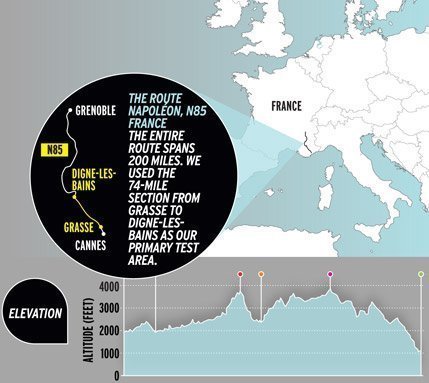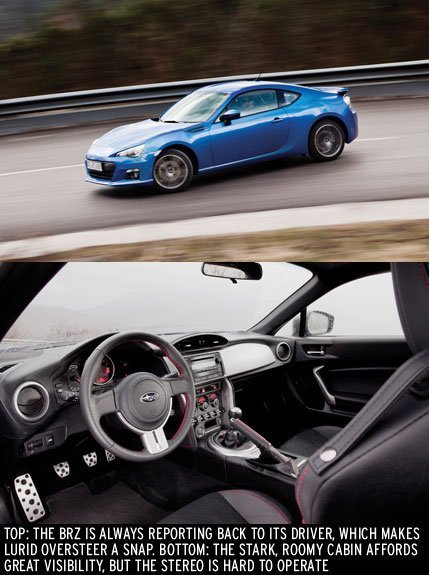
 Instrumented Test
Instrumented Test
This is a story of unlikely scenarios. The first concerns the Subaru BRZ, a rear-wheel-drive sports car from the company famous for making all-wheel-drive station wagons pretending to be SUVs. It’s equally unlikely that this Japanese car finds itself on southern France’s Route Napoléon, one of Europe’s best driving roads and the main link between swanky Cannes on the Côte d’Azur and the base of the French Alps in Grenoble.
We’re here because this is a road of reclamation. Deposed French emperor Napoléon Bonaparte followed it in 1815 to take back his throne. We want to see if the Japanese can reclaim theirs as kings of the simple, affordable, well-built, great-handling sports coupe. We plan to drive the BRZ hard over the route in pursuit of its bona fides. We hope it won’t end as badly for us as it did for the little guy.
The BRZ (and its Scion FR-S twin) would not exist without Toyota’s cash and additional sales volume. But by all accounts, every mechanical part—the heart and soul of the car—is Subaru’s work. As we drive the grand old sea-hugging boulevards of Cannes at the outset of our trip, gawking pedestrians holler, “Est-ce une Subaru?” and “Que bonne!” This confirms that the styling—Toyota drew it—has hit the mark or that the French love design restraint.


In the stop-and-go traffic leaving Cannes, the BRZ proves to be a pleasant commuter. The clutch pedal is light and progressive; the brakes are firm but not grabby. And a 2800-rpm bump in the engine’s torque curve provides nearly as much twist as the 6400-rpm peak, which makes for good in-town grunt.
Just south of Grasse, 10 miles into our drive, we enter a long underpass covered in, um, grass, as a pack of Porsches overtakes us and fills the tunnel with its euphonious Stuttgart soundtrack. We respond in kind only to learn that the BRZ is two cylinders short of any similarly joyous noise. In fact, our car sounds more like the offspring of a microwave oven and a vacuum cleaner.


For the first 20 or so miles of our trip, the Route Napoléon doesn’t seem to be anything exceptional. There’s a fair amount of traffic, and the few curves we encounter are gentle sweepers that offer little challenge. Likewise, at first glance, the BRZ’s specifications seem unremarkable, equipped as it is with only 200 hp. But dig a little deeper, and things get more compelling. On the cover of the plastic intake manifold is the sole appearance of the Subaru and Toyota names together, signifying the fusion of Subaru’s flat-four engine with Toyota’s port and direct fuel-injection system. Together, they make an impressive 100 ponies per liter. More noteworthy is the engine’s low mounting position. Unlike in other Subarus, the BRZ’s power flow doesn’t need to hurdle any front driveshafts, and thus this car actually delivers on the promise of a low center of gravity with a horizontally opposed engine. Except for the Chevrolet Corvette ZR1’s, the BRZ’s 18.0-inch center-of-gravity height is the lowest we’ve measured.
Having spent less than a year in exile on the Mediterranean island of Elba, deposed French emperor Napoléon Bonaparte decided to stage a Wrath of Khan–like return to power in 1815. With only a few troops, Napoléon landed outside Cannes in Golfe-Juan and during the next seven days proceeded to march north toward Paris. The Route Napoléon traces this historic journey through the Alps to Grenoble, where Napoléon convinced the Royalist troops sent to stop him to switch sides. His second reign, called the “Hundred Days,” is best known for its brevity and the emperor’s eventual defeat at Waterloo. This time, he was exiled to a remote island in the South Atlantic. Today, the Route Napoléon trades on its historic significance to promote tourism throughout the region. Despite being the most direct path from Cannes to Grenoble, the 200-mile route is mostly a two-lane mountain road. Heading north, the serious driving begins just outside Grasse, where the road passes over the Maritime Alps and continues all the way to Digne-les-Bains—a 74-mile run of switchbacks and blind corners.